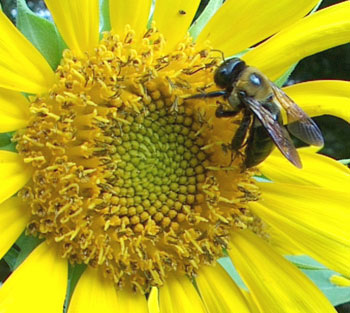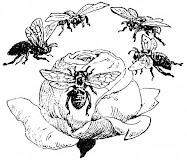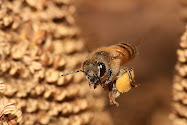Friday was an important day in the development of the apiary. The fence went up – and the bees moved in. Good neighbors Terri Howard and Ron McConnell came over to take a look, as did the building inspector. Ron and Terri’s advice: consider ways to make the fencing vandal-resistant. Building inspector’s instructions: get rid of the tires. Now that someone owns the formerly vacant lot, that someone is responsible for removing any trash dumped there. Meredith is checking into tire disposal and just how many we can dump at the dump.
 - - - The new apiary fence . . . click on photos for a full-screen view
- - - The new apiary fence . . . click on photos for a full-screen viewRobert Steffes and Steve Repasky did all the heavy lifting Friday. The hive from Mt. Washington was picked up and delivered first to the apiary around 10 AM. Then we took off to bring one of Robert’s hives to Mildred’s Daughters Urban Farm in Stanton Heights. Steve noted along the way all the houses from which he had ‘relocated’ raccoons, and squirrels, and bees (oh my) over the years. (Note to Steve: This might make an interesting Rick Sebak special: “Pittsburgh Critters That Ain’t There Anymore.”) Mildred’s Daughters Urban Farm is a good example of why Pittsburgh’s reputation as a city of unique neighborhoods is justly deserved. This 5-acre organic farm, one of the few remaining within the Pittsburgh city limits, is just 10 minutes from downtown, and has been deeded as a farm since 1875. Barb Kline and Randa Shannon "bought the farm" in 1999 from the DiCaprio family, farmers there since 1932. (Read Virginia Phillips' fascinating profile of Mildred's Daughters in the Post-Gazette's archive: http://www.post-gazette.com/food/20030814farmwoman0814fnp3.asp.) Barb and Randa helped found Grow Pittsburgh and are recognized leaders in the local sustainable agriculture community. They gave generously of their time and advice (and some seeds for the apiary) Friday, and showed us around the farm. Joan Guerin, a Burgh Bees steward and Apiary Committee member, will be managing the hive at its new location.
- - - Mildred's Daughters Urban Farm
Joan, Robert, and Steve set up the bees’ new home in a corner of the farm on a bluff overlooking the Allegheny River. The bees will have plenty of southern sun exposure, a bit of shade in the afternoon, (a great view), the company of three very cool dogs and, come May – peeps! Barb and Randa invited us back for a story on their soon-to-be-resident new flock of chickens, and an update on the bees, in early summer. Sincere thanks to Mildred’s Daughters for their hospitality, planting advice – and the bagful of fennel seeds!
 Left: Robert passes the hive tool to Joan
Left: Robert passes the hive tool to JoanRight: Best Buds
A quick stop at Meredith's to pick up her adopted hive and add it to the truck, and then . . .
- - - Meredith's hive


- - - On the road again – to the Ladora Way Urban Farm in Hazelwood. This community garden is in a transitional stage at the moment, waiting for new leadership from the neighbors and property owners. It’s a beautiful, hopeful corner of Hazelwood, tucked away on a side street near the Monongahela River. Over-wintered cabbage plants, strawberries and plantings of thyme were thriving. Robert and Steve loaded the two Burgh Bees hives onto the truck and we were off for Braddock. (For more information on Hazelwood history check out Adam Fleming's 2009 article in the City Paper's archive: http://www.pittsburghcitypaper.ws/gyrobase/Content?oid=oid%3A58473
- - - Ladora Way Urban Farm

- - - Cabbage patch

- - - Thyme
And on a side note: Big Jim’s Restaurant & Bar – “In the Run” – on Saline Street in Hazelwood, was the perfect place to stop for lunch on a Friday afternoon. Big Jim’s is one of those representative Pittsburgh neighborhood establishments that retain the easy charm and friendliness of a local favorite that’s been on the corner – and in the run – for generations. Try the ham and cabbage soup, the sausage hoagie, or the corned beef on Russian rye – and the french fries with beef gravy. Who invented that anyway? We weren’t sure. I thought it was a Pittsburgh original, along the lines of the Primanti sandwich. Steve thought it was a Canadian recipe. It turns out Steve was right (from http://jscms.jrn.columbia.edu/cns/2007-04-10/hirshon-poutine.html):
"Restaurateur Martin Beaudoin wanted to try something different with the
menu at Red Dot when it opened last year in Milwaukee. So the Quebec native
offered his customers a treat from back home: poutine, pronounced “poo-teen,” a
dish of French fries and cheese curds smothered in brown gravy . . . "
"Canadian legend traces poutine to Quebec restaurateur Fernand Lachance. In
1957, a trucker asked Lachance to mix French fries with some cheese curds he
spotted on a nearby counter. Lachance warned the mix would make a mess, or
“poutine” in French slang, but he took the order anyway. The trucker liked the
dish, so Lachance put it on the menu. Within a few months, poutine had become a
regional hit. Lachance added gravy to the recipe in 1964 to help melt the curds."
"Oddly enough, poutine did not spread much beyond Quebec until a few years
ago. Fans tie its emergence as a Canadian national dish to a historic American
event: President Bush’s first run for the White House in 2000. On the campaign
trail, a comedian posing as a journalist convinced Bush that the Canadian prime
minister’s name was Jean Poutine, and that he was endorsing Bush’s candidacy.
The prank aired on a popular Canadian sketch show and pushed poutine permanently
into the limelight."
If you like Primanti's you'll like Big Jim's. And you'll like Guy Fieri's website Diners, Drive-ins and Dives (http://www.foodnetwork.com/diners-drive-ins-and-dives/index.html), where I found Emeril's recipe for fries and gravy: http://www.foodnetwork.com/recipes/emeril-lagasse/poutine-fries-and-gravy-recipe/index.html. Yinz will love it.



We headed out to Braddock next, our last stop for the day. Lots of stuff has been written about, tossed about, and dissed out about Braddock recently, and Robert mentioned that Braddock’s mayor, John Fetterman, would be on the PBS program NOW that very evening. (You can still catch the program online at http://www.pbs.org/now/shows/615/index.html.) No question Braddock, the mayor, the closing of UPMC – n’at – makes for spirited conversation around Pittsburgh. Check out the links below, from the PBS site, for a sampling:
The town of Braddock's website:
http://www.15104.cc/
The New York Times: Braddock Journal—Rock Bottom for Decades, but Showing Signs of Life:
http://www.nytimes.com/2009/02/01/us/01braddock.html?_r=3&pagewanted=1
The Pittsburgh Channel: UPMC Braddock Hospital Closure Stuns Struggling Community:
http://www.thepittsburghchannel.com/news/21313350/detail.html
The Pittsburgh Channel: Green collar jobs in Braddock:
http://www.thepittsburghchannel.com/news/19232432/detail.html
But we’re here to round up the Braddock bees, and the former Convent at St. Michaels, where the hives sit in a sunny corner of the back garden, protected from the wind by a high wall in winter, and surrounded by dense stands of knotweed and goldenrod in the summer, has one feature the other locations today did not: stairs. Here’s where the hive carrier really comes in handy. Looks like the tops of two aluminum chaise lounge chairs, whacked off in the middle and held together with a couple of bolts. (You could make a cool 60 bucks selling these gadgets online . . . ) But no, it’s really a “Hive Carrier” and did prove indispensable at Braddock.
Braddock was the last pickup in The Great Hive Migration, and now we’re taking the bees home to the apiary on Susquehanna Street. The six hives Robert and Steve set up today may be rearranged slightly in the days to come, but right now they are facing the south, the apiary back wall, and the busway fence. The fence will be planted with trumpet vine later this year – bees love trumpet vine – and on Saturday, April 24th, our second Apiary Workday, Burgh Bees members and volunteers will be out planting sunflowers, goldenrod, and black-eyed Susans along the busway fence, wildflowers in the meadow zone to the right of the apiary, and various shrubs and flowers around the newly installed apiary fence. If you’re not in ‘digging distance’ – or even if you are – send us your comments, questions, or photos of your own pollinator garden. We’ve started a list of links to the right of this page – send in your own recommended sites.

- - - Robert and Steve making use of the Hive Carrier

- - - Six hives in their new home

- - - Apiary Workday 2 planting zones
Finally, a great site to visit for all beekeepers, wannabees, and folks interested in pollinators and gardens is The Great Sunflower Project: http://www.greatsunflower.org/. We ordered some sunflower seeds from them for the apiary, and plan to participate in their ongoing project to monitor bees, sunflowers, and important pollinator issues. Join us!








No comments:
Post a Comment